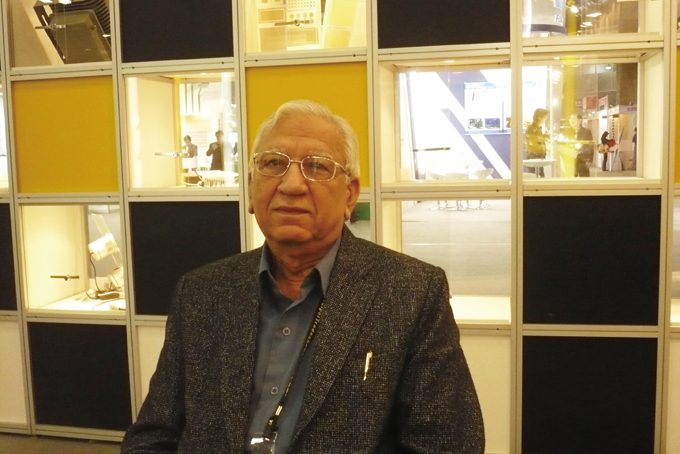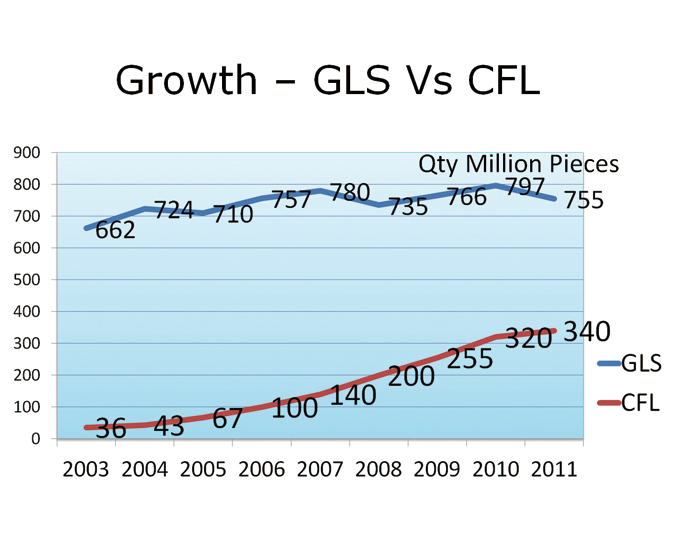An Interview with Shyam Sujan, Secretary General of ELCOMA of India
2012/10/12 | By Ken LiuShyam Sujan, Sectary General of India’s Electric Lamp & Component Manufacturers’ Association (ELCOMA), hopes that compact fluorescent lamps (CFLs) will replace incandescent lamps in India in three to four years under the United Nations Clean Development Mechanism carbon credit scheme.

The brisk economic growth of the past few years has given an enormous boost to India’s lighting market, which has been expanding at an annual rate of around 15% for years. However, as most of the country’s more than one billion people are still living in poverty, promoting the replacement of cheap, relatively energy-hungry incandescent bulbs with expensive, energy-saving lamps there is a tough challenge.
Now, the Indian government has introduced a string of measures to encourage the use of LED lamps and make use of the UN’s carbon credit scheme to increase CFL buying.
During his stay in Taiwan for the Taiwan International Lighting Show 2012 in March, Sujan offered his views on the development of India’s lighting market in an interview with CENS Lighting Magazine. Excerpts:
Q: What is the size of the Indian lighting market today?
A: The Indian lighting market is estimated at US$2 billion in revenue. The market grew 17% in 2011; there has been very good growth, between 14 and 16%, for many years because of the rapid growth of the Indian economy. We expect the growth to continue at least four to five years at the same rate—14-16%.
Q: What is India’s dominant lighting technology now?
A: India’s dominant lighting technology is CFL [compact fluorescent lamp]—400 million units in retail sales a year. Now we have a manufacturing capacity of 730 million CFLs a year, and next year the capacity will increase to an estimated 1 billion. So, we’ll have extra capacity to export.
Q: China has the world biggest CFL manufacturing capacity. Is there any competition between India and China?
A: Not in the Indian market, because we have mandatory standards and you cannot bring in any materials from China unless you have certificates from the Indian standards organization—the Bureau of Indian Standards. The mandatory standards are under government rule and no one can break them. Secondly, India has its own capacity. So we are able to sell within the Indian market with much more competitive prices than those of imports from China, where you have a lot of transportation, duty and other costs which make China-made products expensive in India.
A: China and many economic powers have announced timetables for banning incandescent bulbs. Does the Indian government have any similar plan?
Q: India cannot think of phasing out incandescent lamps at this stage. We are still selling 800 million to one billion incandescent bulbs per year, because they are only one tenth the price of CFLs. In India, poor people cannot afford a 100-rupee CFL or LED. Therefore, the Indian government is waiting for the right time to promote more CFLs and discourage incandescent lamps. And there are lots of schemes going on to promote CFLs.
Q: How is the Indian government promoting CFLs? Does it offer any incentives?
A: Yes, the Bachat Lamp Yojna, which is a United Nation carbon credit scheme, allows the government, investors, discoms [distribution companies], and CFL manufacturers to sell CFLs at 15 rupees each, instead of the 100 rupees they currently cost on average. This scheme will help India replace 400 million incandescent light bulbs with CFLs while preventing 40 million tones of carbon from entering the atmosphere annually.
For every ton of carbon saved, the Bureau of Energy Efficiency [of India], acting as the anchor, gets a carbon certificate from the UN, which it then hands it over to the suppliers. The suppliers can sell the credits on the international market.
Q: How is this scheme coming along?
A: Under the carbon scheme, which the UN calls the Clean Development Mechanism, the Bureau has launched a program which we’re trying to carry out; it’s not very large, but the main problem is finance. Some financial companies are investing money in CFLs, but their investments have been slow because the payback is slow—about five to seven years. So we cannot get the whole country to do the program in a big way. Instead, we’re doing it slowly and gradually and hope in another three to four years, incandescent lamps will be replaced by CFLs.
Q: Is it a viable program?
A: Yes, it is in the long run. The Indian government is looking for some big financial people to work with it. If we carry on the program for one or two years, I believe we can have some 400 million CFLs replacing incandescent lamps.
Q: Do you expect incandescent to be phased out of the Indian market in maybe 10 years?
A: Incandescent lamps are not growing, or are growing only one or two percent a year, in India. But there is a lot of development. Incandescent bulb consumption in India was 662 million units in 2003; in that same year, India’s CFL consumption numbered 36 million units. By 2011 incandescent bulb consumption had risen moderately to 755 million units in India, with the irregular line representing market change on the bar chart fluctuating moderately between 2003 and 2011. But the line representing CFL market change on the same chart moved steadily upward to a consumption volume of 340 million units in 2011. We expect the gap between the two lines to narrow down further over the next 10 years.
Q: Is LED an unviable lighting product in India, given its high price?
A: LED is a very expensive lighting technology. We have a national program in India under which we’ve identified certain areas where we can generate volume. No.1 is secondary roadway streetlights.
The BEE [Bureau of Energy Efficiency] intends to provide over 100 municipalities with LED streetlights. The Ministry of Commerce has issued an advisory to the Ministry of Urban Development to ensure that all medium and small municipalities change to LED street lighting.
The Bureau has started pilot programs to encourage municipalities and local bodies to install LED streetlights on secondary roads, parks, and parking areas by funding them. Now, funding is being provided to 180 bodies.
Huge purchases of LED streetlights planned for government projects will create a large demand and encourage the industry to develop. ELCOMA is preparing streetlight specifications for government procurement and end users, while the BEE is preparing streetlight guidelines.
The second area is down lights. Indian people mostly use halogen lamps as down lights, because they are cheap. Therefore, we are planning to replace halogen down lights in the country’s showrooms and show windows with LEDs. ELCOMA is also preparing specifications for these lights.
The Ministry of Commerce has issued notification to the Delhi Municipal Government to ensure that all showrooms and show windows using incandescent or halogen lamps will immediately replace them with LED down lights.
For end users, the government will provide all households within 5 k.m. of power plants with one LED bulb free of charge.
Q: How is the LED business developing in India?
A: As you said, LED is expensive and most Indian consumers cannot afford it now. So the market in India is still small. But it has a lot of potential. In 2009, the market size was about R300 Crores (US$53.7 million at US$1:R55.7) in terms of revenue. It grew to R850 Crores (US$152 million) in 2011. And we estimate the Indian market will rise to R5,000 Crores (US$897 million) in 2016.
To promote LED lighting, we have staged several trade fairs in Delhi, Hyderabad, and Mumbai. In October this year, we will hold a show in New Delhi. More workshops are being organized in Kolkata, Bangalore, Chandigarh, and Ahmedabad between 2012 and 2013.
In terms of manufacturing, now we have 12 large, 15 medium, and around 600 small LED manufacturers, and all world-leading chipmakers have offices in India. LED binning and packaging operations have just begun in India, where most large LED companies have tied up with world-leading luminaire manufacturers to set up manufacturing operations.
To ensure product quality, the Indian government has provided around R25 Crores [US$4.4 million] as funding for existing test labs to establish test facilities. So far, six labs have taken the initiative. By 2013, we expect a total of 12 LED test labs to be opened—and in 2010 we did not have a single LED product test lab. Currently, ELCOMA is working with large test labs to upgrade LED testing.
Q: The Indian government has pledged to build more nuclear power plants to keep up with economic development. But how serious is the energy shortage in India?
A: In India, there has been a huge gap between power supply and demand. The more power we generate, the more power we need because of the economic boom. We are not able to close that gap because it grows 8% every year. Suppose we add 12% more power; demand will grow 20%. That’s a heavy shortage. Both domestic and industrial consumption are suffering shortages. So, the best thing to do is initiate nuclear power-plant projects.


